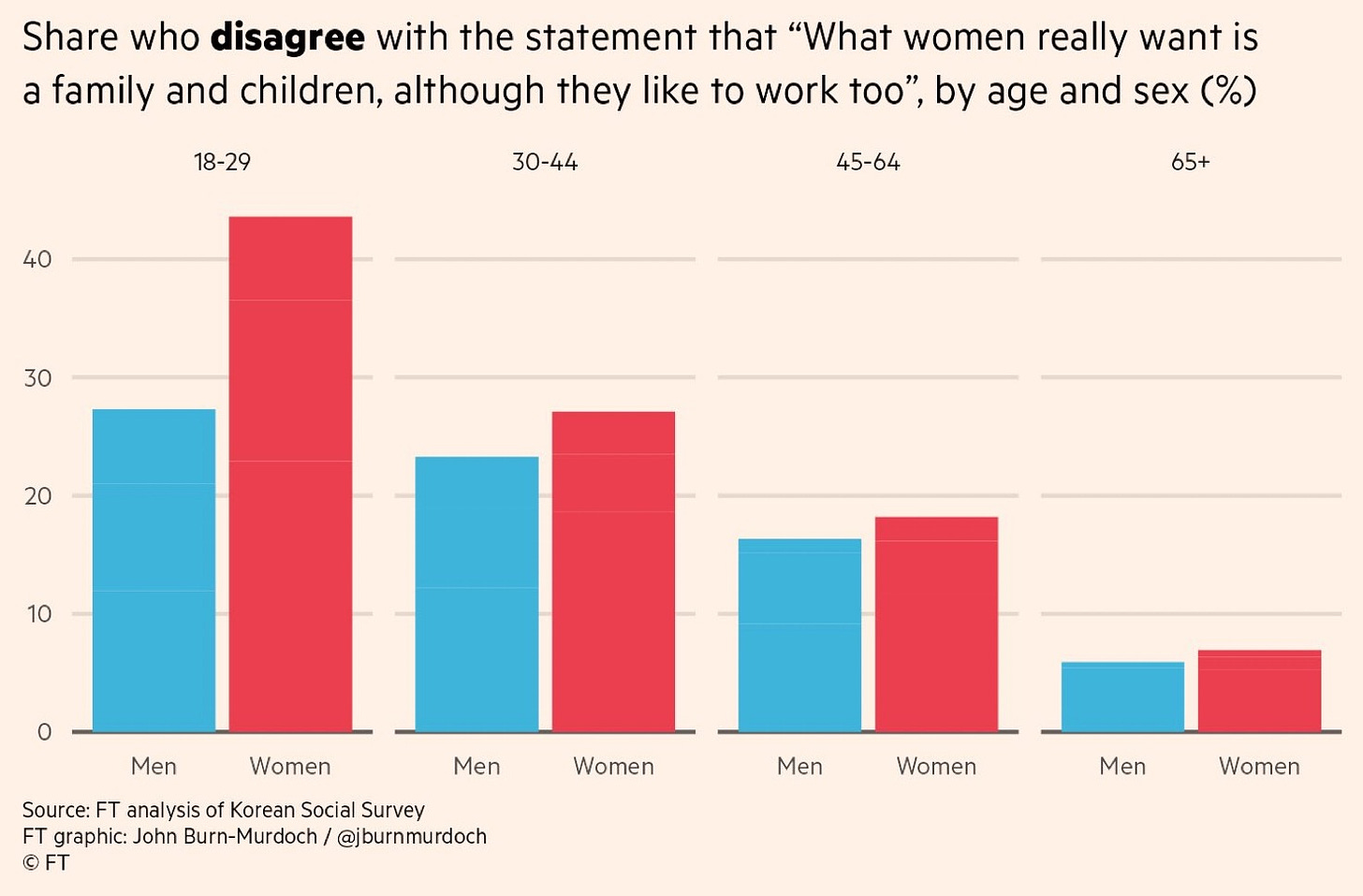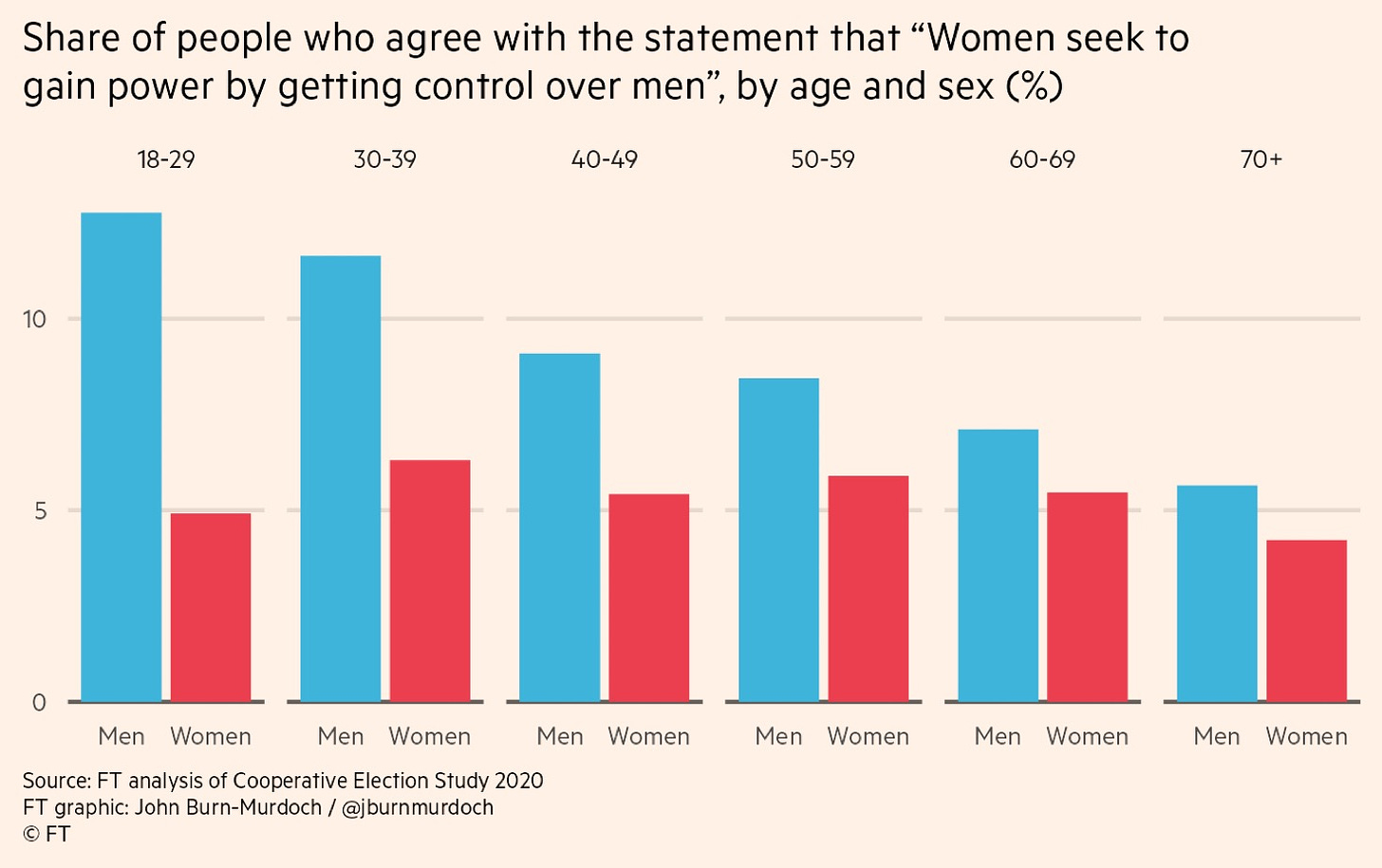With a small nod to International Women’s Day, I am republishing here over the next three days three pieces that were originally published on my Substack newsletter, Just Two Things.
—
The data journalist John Burn-Murdoch is consistently one of the most interesting writers on the Financial Times.
A recent FT article, which was also the subject of a long thread on ex-Twitter, points out some dramatic changes in political and social attitudes between young men and young women. In fact, this piece is likely to be mostly a set of charts. Here’s the headline data for the changing social and political attitudes of young men and young women, from 18-29 years old, in South Korea, the United States, Germany and the UK.

Just for clarity, the data points at any moment in time show the attitudes of the 18-29 year olds at that time.
There are four elements in all of this that are immediately striking.
Gender divergence
The first is that the gender divergence in attitudes is—in research terms—obviously significant. It’s around 25 percentage points in Britain, 30 in the Germany and the United States, and off the scale in South Korea.
The second is that, historically, as Burn-Murdoch says in his FT article:
One of the most well-established patterns in measuring public opinion is that every generation tends to move as one in terms of its politics and general ideology. Its members share the same formative experiences, reach life’s big milestones at the same time and intermingle in the same spaces.
The third, also historically, is that women’s attitudes have—certainly in richer countries—been more conservative than men. There are theories about why this was that may also be relevant to what’s changing now.
Fourth, this isn’t just about women. Something is going on with men as well, and not in a good way.
Feminist values
Burn-Murdoch’s explanation of this divergent is the #MeToo movement:
The #MeToo movement was the key trigger, giving rise to fiercely feminist values among young women who felt empowered to speak out against long-running injustices. That spark found especially dry tinder in South Korea, where gender inequality remains stark, and outright misogyny is common.
That might be true of South Korea, but just looking at the data for the US, Germany, and the UK, the divergence comes earlier, around 2010.
That women (of all ages) used to be more conservative than men was typically explained by their greater connection to the church and lower exposure to the workplace and social institutions such as trades unions.
Several decades
In general, there have been signs that this has been changing for several decades. An article by Rosie Campbell and Rosalind Shorrocks in The Conversation quotes work by Inglehart and Norris from 2000, which described this as a generational process:
In this model, younger cohorts of women, who have experienced higher labour force participation, higher education, and less traditional gender roles, become more economically left-leaning, socially liberal and supportive of gender equality. This pushes them to the left of men in their party choices.
Looking specifically at the data on young women, it’s also clear that their more progressive views are not just about gender. Burn-Murdoch says:
In the US, UK and Germany, young women now take far more liberal positions on immigration and racial justice than young men, while older age groups remain evenly matched. The trend in most countries has been one of women shifting left while men stand still, but there are signs that young men are actively moving to the right in Germany, where today’s under-30s are more opposed to immigration than their elders
Explanations
The best explanation for what might be happening here comes from Alice Evans’ newsletter The Great Gender Divergence. Burn-Murdoch thanks Evans, an academic, for helping him with his thinking and research, and in a piece published this week she offers a synthetic theory of those factors that might reduce gender divergence, and those factors that might increase it.
The factors that might reduce it:
Men and women tend to think alike in societies where there is
- Close-knit interdependence, religosity and authoritarianism, or
- Shared cultural production and mixed gendered offline socialising.
So these are at opposite ends of the spectrum—the first would lead to convergence around relatively traditional views, while the second would likely be more progressive. I haven’t the space to discuss this here, but she has a qualitative stories about Morocco, India, and Turkey in the article to discuss how the first works in practice, and about Catalonia for the second of these.
Polarisation
Increased gender polarisation might, she says, come from:
- Feminised public culture
- Economic resentment
- Social media filter bubbles
- Cultural entrepreneurs.
Here, she discusses South Korea and China as examples from Asia, and then a section using data from a set of Western countries. The critical question here is what’s happening with young men.
I’m going to come back to some of this in Part 2, because the explanation is quite nuanced. For the moment, it’s worth noting a couple of data points from a couple of different countries about the attitudes of young men.
Woman and work
Here’s a survey question from South Korea about women and work:

Burn-Murdoch:
Here’s South Korea, where the ideology divide between young men and women is famously wide. Young women have become markedly more progressive on gender norms, but young men have not budged.
To spell this out: young men (18-29) are more likely to disagree with this than older men (actually, they’ve budged a bit), so this effect is not as strong as the headline divergence between genders in South Korea.
All the same, some of the effects might be far-reaching:
This is having huge impacts, including reducing rates of marriage and births in Korea, whose birth rate has plummeted to become the lowest of any country in the world.
Suspicious
In the United States, in contrast—this is a very different question, and it’s worth noting that these are all relatively low percentage numbers—but all the same, young men are more likely to be more suspicious of women than older men.

It’s possible that these polarised views will start to converge again. But it’s also possible that they won’t. One of the other beliefs in the social attitudes literature is that, broadly, your attitudes about the world tend of harden as you move into your thirties.
But I’m still puzzled by the timing. What happened around 2010 that caused these similar effects in US, Germany, and the UK? I can’t help thinking I’m missing something obvious here.
But I don’t think it’s just the smartphone”, which is the obvious answer. More in Part 2 tomorrow.
(Thanks to Ian Christie for the tip.)
—-
A version of this article is also published on my Just Two Things Newsletter.